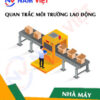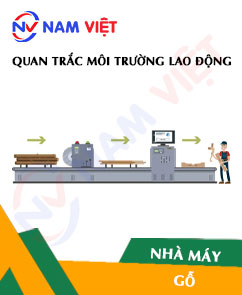Occupational Environmental Monitoring for Chemical Factories
99,000 ₫
Note: The above price is calculated per sample, and the price may fluctuate depending on the area of the environment to be monitored and market movements. For more accurate pricing support, please refer to the pricing table or contact our consulting staff directly.
Chemical factory environmental monitoring is a session of collecting, analyzing, and evaluating workplace factors that may be harmful to workers health.
Table of Contents
Toggle1. Overview of Chemical Factories
a. What is a Chemical Factory?
The chemical industry is a branch of chemical technology, particularly focused on the manufacturing of various chemicals. It includes the production, transformation, and utilization of organic, inorganic, and specialty chemicals. Chemical products serve industrial, food technology, pharmaceutical, and everyday life purposes.
A chemical factory is a facility where chemicals are manufactured. Chemical factories can be classified into various types, such as oil chemical factories, water chemical factories, and industrial chemical factories.
In a chemical factory, raw and organic materials are processed through chemical reactions and transformations. These processes require precise control of temperature and pressure and can generate end products that may need further handling and processing.
Chemical factories must comply with safety and environmental regulations, including regulations on emissions and waste. Compliance ensures the health and safety of workers and surrounding communities, while keeping the environment clean and natural.
In summary, chemical factories are an essential part of chemical technology and provide many important chemicals for various industries. However, chemical manufacturing can have adverse effects on the environment and human health, making control and mitigation measures extremely important.

b. Manufacturing processes in chemical factories
Chemical factories include many different manufacturing processes, depending on the specific product being produced. The main stages usually include:
- Raw material preparation: This stage involves purchasing and inspecting the quality of materials needed for manufacturing. These materials can include chemicals, gases, oils, water, or other substances.
- Chemical reactions: After raw materials are prepared, they are mixed and fed into reaction tanks for chemical reactions. Specific conditions are required to ensure optimal reaction performance.
- Separation and filtration: After reactions are complete, products are separated from unwanted substances such as waste or by-products. Techniques include settling, concentration, washing, aeration, or using devices such as filters or centrifuges.
- Product testing: Samples are taken to verify quality, ensuring they meet required standards before moving to the next stage.
- Packing and transportation: Once products pass quality checks, they are packed appropriately and stored for shipment.
Each chemical factory may have different processes and technologies tailored to its products, but these basic steps are essential in chemical manufacturing.
c. Machinery used in chemical factories
Machinery and equipment play a crucial role in chemical manufacturing. It is essential to select appropriate machines and equipment to ensure quality and safety.
Chemical manufacturing equipment must meet requirements such as high quality, durability, reliable control and management features, and safety. Machinery must also comply with environmental and safety regulations.
Depending on specific processes, different types of equipment may be used. For instance, manufacturing chemicals with high pH requires machinery resistant to corrosive environments.
Common machinery used in chemical manufacturing includes:
- Reactors: Used to produce chemicals through controlled chemical reactions.
- Distillation columns: Used to separate chemicals based on differences in vapor pressures.
- Filters: Used to remove particles or contaminants from chemical products.
- Pumps: Used to transport chemicals through manufacturing processes.
- Heat exchangers: Used to transfer or control heat between chemical substances.
- Storage tanks: Used to store chemicals after production.
- Process control systems: Used to monitor and control chemical processes to ensure safety and quality.
These are just some of the many types of machinery used in chemical manufacturing.

d. Occupational diseases in chemical factories
Workers in chemical factories may be exposed to various occupational diseases due to contact with hazardous chemicals and harmful agents. Common occupational diseases in the chemical industry include:
- Lung diseases: Workers exposed to dust and harmful chemicals for prolonged periods may develop conditions such as pneumonia, chronic obstructive pulmonary disease (COPD), and lung cancer.
- Skin diseases: Contact with chemicals can cause skin irritation, rashes, bleeding, dermatitis, and other skin conditions.
- Nervous system disorders: Hazardous chemicals such as benzene and solvents can lead to neurological issues, including headaches, dizziness, paralysis, and vision problems.
- Cardiovascular diseases: Exposure to toxic chemicals and work stress may lead to hypertension and heart disease.
- Cancer: Many hazardous chemicals used in production can cause cancers such as lung, liver, and skin cancer.
2. Overview of Occupational Environmental Monitoring Services
a. What is occupational environmental monitoring in chemical factories?
Occupational environmental monitoring in chemical factories involves collecting, evaluating, and analyzing measurements of workplace environmental factors to promptly address hazards, minimize health risks for workers, and prevent occupational diseases. Environmental monitoring is mandatory for chemical manufacturing factories.
It plays a key role in protecting worker health because workers are the primary resource and directly generate profit for factories. Workers regularly exposed to hazards beyond permissible levels are at risk of health issues and occupational diseases.
REGISTER FOR OCCUPATIONAL ENVIRONMENTAL MONITORING SERVICE
b. Nam Viet’s Occupational Environmental Monitoring Program
Nam Viet’s Occupational Environmental Monitoring Program was developed by engineers specialized in occupational safety and environmental protection. Aiming to ensure worker health and safety, the program uses modern measurement methods to monitor air, water, microclimate, physical factors, and dust levels in the workplace. This program is essential for creating a safe work environment and protecting workers’ health.
Additionally, the program helps research and develop solutions to improve workplace environmental quality. With professional and dedicated specialists, Nam Viet’s exclusive monitoring program represents a breakthrough in labor safety and environmental management in Vietnam.
c. Standardization in occupational environmental measurement procedures
Standardization in Nam Viet’s monitoring procedures is crucial for ensuring measurement accuracy and reliability. The program follows recognized standards and procedures from the Ho Chi Minh City Department of Health. This ensures high-reliability data for evaluating workplaces and making decisions to improve occupational safety and worker health.
Standardized procedures also ensure that measurements conducted by qualified monitoring specialists are trustworthy, allowing managers and experts to make informed decisions to protect health and the environment.
By applying standardization in measurement procedures, Nam Viet demonstrates its commitment to providing safe workplaces, protecting worker health, and contributing to enhanced occupational safety and environmental management in Vietnam.

d. Reporting occupational environmental monitoring results for chemical factories
Monitoring results are prepared according to Form 04, Appendix III issued with Decree 44/2016/ND-CP and made in two copies: one copy is sent to the workplace that contracted the monitoring service, and one copy is retained by the monitoring organization.
The storage duration for monitoring results follows legal regulations and is maintained indefinitely.
e. Frequency of occupational environmental monitoring as per legal regulations
According to Clause 2 of Article 18 of the Law on Occupational Safety and Hygiene 84/2015/QH13, employers must organize occupational environmental monitoring to assess harmful factors at least once a year.
f. Deadline for submitting occupational environmental monitoring reports
Reports must be submitted before December 31 each year. Enterprises of production facilities must submit monitoring results to the Department of Health at the locality where the head office and workers are located.
When there are changes in production technology, manufacturing processes, or upgrades that may generate new hazards, enterprises must update occupational safety records with relevant harmful factors requiring environmental monitoring.
g. Penalties for violations regarding occupational environmental monitoring for employers
According to Article 27 of Decree 12/2022/ND-CP dated January 17, 2022, regulating administrative penalties in labor, social insurance, and overseas labor contracts:
- Clause 2: Fines from 2,000,000 – 5,000,000 VND for employers failing to publicly disclose environmental monitoring results and risk management information to workers at monitored workplaces.
- Clause 3: Fines from 20,000,000 – 40,000,000 VND for employers who do not perform environmental monitoring to control health hazards according to legal regulations.
- Clause 4: Fines from 40,000,000 – 60,000,000 VND for employers who collude with monitoring organizations to commit fraud in environmental monitoring activities without reaching the level of criminal liability.
3. Harmful Environmental Factors for Workers in Chemical Factories
Harmful environmental factors for workers in chemical factories include:
- Toxic gases: Some chemicals used in manufacturing, such as vinyl chloride, vinyl acetate, benzene, formaldehyde, phthalic anhydride, isocyanate, etc., can release toxic gases that are harmful to workers’ health.
- Dust and particles: Manufacturing processes in chemical factories often generate dust and large particles, which can irritate the respiratory system and cause lung diseases.
- Temperature and humidity: Extremely high or low temperature and humidity can affect workers’ health, causing conditions such as fatigue, headaches, dizziness, and sleep disorders.
- Lighting: Workers in chemical factories are often exposed to strong light from manufacturing equipment, factory tools, or lighting systems, which can harm the eyes and affect health.
- Noise: Manufacturing equipment and machinery in chemical factories often produce loud noise, which can damage hearing and affect workers’ health.
REGISTER FOR OCCUPATIONAL ENVIRONMENT MONITORING SERVICE
4. Measures to Improve Working Environment in Chemical Factories
To improve the working environment in chemical factories, factories need to implement the following important measures:
- Comply with occupational health and safety regulations: Occupational health and safety regulations are mandatory for all chemical factories. This includes providing full personal protective equipment to workers, training workers on proper use of this equipment, and developing emergency response plans.
- Optimize manufacturing processes: Optimizing manufacturing processes is one of the most important ways to minimize workers’ exposure to hazardous chemicals. This can be achieved by using modern and advanced technologies, reducing exposure to hazardous substances during manufacturing, and establishing proper waste handling procedures.
- Create safe working areas: Safe working areas can be established by using fire-resistant materials, installing effective ventilation systems, and using protective equipment to minimize fire and explosion risks.
- Ensure environmental hygiene: Chemical factories need to ensure that waste is properly treated and does not pollute the environment. Measures such as recycling, reusing, and proper waste treatment can help reduce pollution and protect the environment.
- Train workers on safety and environmental protection: Factories must provide comprehensive training on safety and environmental protection to help workers understand workplace hazards.
- Conduct periodic occupational environment monitoring: This is an important activity to ensure workers’ safety and health in chemical factories. It includes measuring, recording, and assessing workers’ exposure to hazardous substances and other environmental factors such as light, humidity, and temperature.

5. Benefits of Periodic Chemical Factory Monitoring
An Toan Nam Viet provides businesses with excellent benefits when using occupational environment monitoring services in accordance with Decree 44/2016/ND – CP regarding the management and control of harmful factors in the workplace.
- Businesses can proactively control harmful factors in their factory or workshop.
- Receive advice and recommendations on measures to reduce harmful factors and improve the working environment.
- Indirectly protect human resources, a key factor in business development.
- Minimize the impact of occupational diseases on workers’ health, reducing future treatment costs.
- Improved worker health ensures product quality and maintains production output.
- Comply with occupational safety laws, avoiding legal risks.
- Create credibility and professionalism, enhancing your company’s brand.
Nam Viet’s environment monitoring service is a solution to reduce the impact of occupational diseases, contributing to a clean and high-quality working environment.
6. Nationwide Occupational Environment Monitoring Center
Nam Viet’s Occupational Environment Monitoring Center is a professional unit providing monitoring and measurement of occupational environment quality across all provinces in Vietnam. With an experienced team of monitoring specialists, the center uses modern measurement equipment to ensure accuracy and reliability.
In addition to monitoring services, the center assists clients in planning, handling, and tracking occupational environment issues. With the motto “customers at the center,” the center focuses on client satisfaction, meeting all client needs, and committing to provide the best solutions for businesses.
REGISTER FOR OCCUPATIONAL ENVIRONMENT MONITORING SERVICE
With investment in technology, equipment, and personnel, Nam Viet’s monitoring center has become a reputable unit in occupational environment monitoring in Ho Chi Minh City with the following objectives:
- We always value our brand reputation and service quality.
- We provide clients with the best and most suitable solutions.
- Along with a team of experienced Masters and Engineers, committed to environmental protection and business benefits.
- Clients working with Nam Viet’s Monitoring Team will receive professional service from experts and the best cost advantages.
The occupational environment monitoring process at Nam Viet includes:
- Before monitoring, our company ensures all machinery and equipment used for monitoring are calibrated according to legal regulations.
- Carry out the full monitoring process as committed to the Department of Health.
- Report occupational environment monitoring results truthfully to the employer.
- If the monitoring results do not ensure worker safety, Nam Viet will assist in providing solutions, and the factory will implement:
- Implement measures to improve working conditions, minimize exposure to harmful factors, and prevent occupational diseases.
- Organize health check-ups to detect occupational diseases and related conditions for workers in hazardous areas.
- Provide material compensation to workers according to labor law regulations.

7. Occupational Environment Monitoring Price List
To help businesses conduct occupational environment monitoring professionally and effectively, Nam Viet provides clients with a detailed and reasonably priced monitoring service price list.
- Our price list provides detailed information about the cost of monitoring services, including transportation, measurement, analysis, and reporting. Clients can fully trust the accuracy and reliability of the monitoring reports we provide.
- We are committed to offering competitive and reasonable prices, and are always ready to quickly and professionally answer any questions about our monitoring services.
- With Nam Viet’s price list, clients can easily select services that suit their needs. We are committed to delivering maximum satisfaction with professional service quality.
1 review for Occupational Environmental Monitoring for Chemical Factories
No comments yet











maituyet.cuong12
Professional labor environment monitoring unit